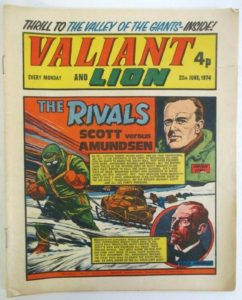
Roald Amundsen’s original expedition plan was to seek the geographic North Pole, but two expeditioners, Cook and Peary, had in September 1909 been reported to have achieved that goal. Keen to continue a polar expedition Amundsen turned his attention to the South Pole, but kept the revised plans under wraps. The Fram had been undertaking sea trials since leaving Norway and was now in the eastern Atlantic. Cook and Peary’s claims to be the first to the North Pole were in fact later discounted, Amundsen successfully achieving that goal in May 1926 by airship. Amundsen acknowledged the disquiet his secret change of plans generated later writing: “I know that I have been reproached for not having at once made the extended plan public, so that not only my supporters, but the explorers who were preparing to visit the same regions might have knowledge of it. I was well aware that these reproaches would come, and had therefore carefully weighed this side of the matter.”
6th September 1910. The Fram arrived in Funchal, Madeira.
9th September 1910. 6pm it was announced that the plan of the expedition had expanded to also include the south polar area. Everyone agreed to go along and the Fram departed Madeira. Amundsen wrote ‘I considered it an imperative necessity that every man should acquaint himself as far as possible with the work of previous expeditions; this was the only way of becoming in some measure familiar with the conditions which we should have to work. For this reason the Fram carried a whole library of Antarctic literature, containing everything that has been written by the long succession of explorers in these regions, from James Cook and James Clark Ross to Captain Scott and Sir Ernest Shackleton.’
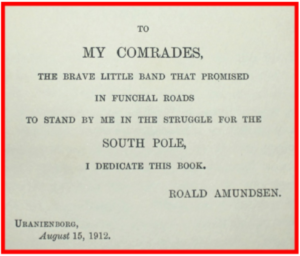
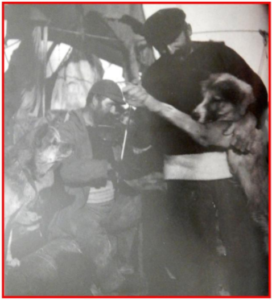
4th October 1910 The Fram crossed the equator and headed south.
“According to ancient custom, crossing the line should be celebrated by a visit from Father Neptune himself, whose part is taken for the occasion by someone chosen from the ship’s company. If in the course of his inspection this august personage comes upon anyone who is unable to prove that he has already crossed the famous circle, he is handed over at once to the attendants, to be shaved and baptized….. Many on board the Fram looked forward with eagerness to Neptune’s visit, but he did not come. There was simply no room for him on our already well occupied deck. We contented ourselves with a special dinner, followed by coffee, liqueurs, and cigars. “
In the absence of available dance partners for the crossing of the equator party, the dogs stepped in (perhaps reluctantly) to join in the conviviality.
The end of October 1910 brought a fresh northerly breeze driving the Fram and her crew to 40 degrees south where they picked up the west wind belt. They had planned to be south of the Cape of Good Hope within two months of leaving Madeira and this was achieved. They were now heading directly for Antarctica.

Scott’s Terra Nova expedition had left Madeira in July 1910 after taking on coal and headed south, not to Antarctica, but first to South Africa where Scott boarded the ship having been personally delayed on expedition business back in England. Thence on to Melbourne in Australia where Scott left the ship to engage in expedition fund-raising – he would re-join the Terra Nova in New Zealand. Waiting for Scott in Melbourne was a telegram from Amundsen informing him of the Norwegian’s revised plans and that the Fram was now proceeding to Antarctica.
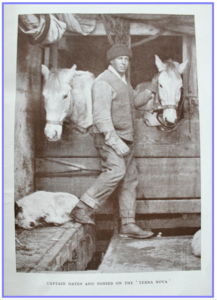
28th November 1910. The Terra Nova left Port Chalmers in New Zealand’s South Island. Aboard were thirty-three dogs and fifteen ponies, under the watchful eye of Lawrence Oates. His years in the army had given him a great ability with horses.
2nd December 1910. A severe gale blew up and water began to flood the deck of the boat. The ponies struggled to stand in their stalls and sacks of coal washed around the deck. The Terra Nova was heavily loaded and was very low in the water meaning that it was vulnerable to heavy seas. The pumps were failing and the ship was taking on water so the crew formed lines and baled using buckets. They lost ten tons of coal and numerous cases of petrol. One dog drowned and another was washed overboard. Two ponies died and many of the dogs needed careful nurturing to help them recover from their ordeal.

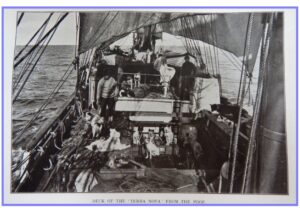
The photographer on the Terra Nova expedition, Herbert Ponting, commented: “a full gale was howling and shrieking through the rigging, and tearing and roaring over the now mountainous waves. The ship rolled and plunged and squirmed as she wallowed in the tremendous seas….”
During the gale (recorded in the ship’s log as Force 10) Osman, one of the dogs, was washed overboard, but then miraculously was washed back on to the deck again and grabbed by one of the sailors. Though thoroughly traumatised and exhausted he completely recovered and served with honours throughout the expedition as leader of the pack, spending his retirement with friends in New Zealand.
Both Scott’s and Amundsen’s expeditions were now heading for the ice with plans to set up bases during early 1911 and lay supply depots for the overland journeys to the geographic South Pole at the end of 1911. We will catch up with them again in December when the crews of the Fram and the Terra Nova encounter the first signs of ice and make festive for Christmas and mid-winter.
